

|
Home Updates Hydros Cars Engines Contacts Links Contact On The Wire ←Previous page |
|
Betty’s first race of the 1936 season was in June were the speed was well below her previous best at 37.2mph but she still managed first place. Following that, at the International Regatta in the July at Victoria Park, ‘Betty smashed’ the 30cc world record with a speed of 43.07mph just 0.23mph short of the outright record. In the Speed Championship race ‘Betty’ also took first with a speed of 40.66mph. |
|
At the Farnborough Regatta ‘Betty’ had trouble with a broken electrical connection in the ignition circuit, which made the spark very weak and erratic. Managing to sort out the problem just before the end of the meeting the brothers managed to complete 6 laps and achieve an amazing speed of 47.47mph. Unfortunately ‘Betty’ didn’t complete the course but gave a most impressive display and was also unable to claim the famous Farnborough Marrow. The ‘marrow’ was described as being ‘in fine form on account of the wet season, but being evidently of an artistic temperament, had forsaken streamlines and grown into ornate curves. Fully equipped with two Union Jacks, a propeller, sparking plug, and very squiggly high-tension cable, it was quite the handsomest trophy of the regatta.’
The 47.47mph set at Farnborough was recognised as a new outright World Record, breaking Stan Clifford’s 43.3 that had stood for ten years. This was the Innocent Brothers fourth year of competing and with ‘Betty’ had the satisfaction of having the fastest model speedboat of any type in the world. The brother’s teamwork had been richly rewarded, winning them several trophies and setting many speed records. The outright record won them the Windermere Trophy again and a Silver Medal in Class A of the ME Speed Boat Competition.
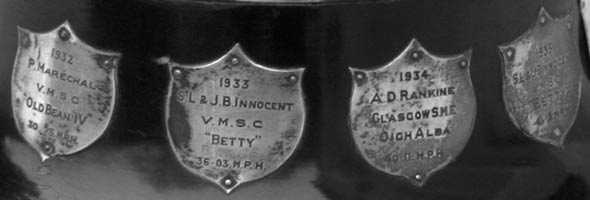
The Windermere Trophy had been anonymously donated in 1930 in memory of Sir Henry Segrave, who had been killed during an attempt on the water speed record. It was awarded to whoever broke an existing record by the biggest margin, providing that the speed was in excess of 25mph. As was the custom at the time, anyone winning the trophy on three occasions, not necessarily consecutively, would win the trophy outright. The Innocent Brothers had won it in 1933 at 36.03 mph, in 1935 at 41mph, and now in 1936 at 47.47mph, thus the trophy became theirs to keep..
Having set the outright record the brothers were not able to enter ‘Betty’ in as many races as in previous years because 'they had been inconvenienced by a change of residence and other circumstances, which have considerably curtailed their model power boat activities.' They had still managed to attend some of the meetings, eliciting the comment that it was disappointing not to see ‘Betty’ racing. John was turning his attentions more to the 15cc B Class, building and describing the construction of a new two-stroke motor. In addition, he had been suffering from ill health.
|
|
John Innocent’s articles show just how much work and development had gone into Betty and the engine, with numerous alterations, new cylinder heads, carburettors, ignition systems and several different designs of pistons, some cast in magnesium for ultra light weight. ‘Betty’ was also fitted with complex linkages to adjust timing, mixture and throttle opening automatically when launching the boat. In a letter to the ME 1937 regarding Cam design and production, John pointed out that racing engines need the cams to provide effective breathing primarily and then modified if the valves floated. It was very much the case of experimentation and he admitted that the sets of cams and followers that ‘Betty’ had owned were, to a considerable extent, made with a file. |
‘Betty’ was again not as reliable as she had once been, suffering from cutting-out problems at the MPBA International Regatta in June, but still fast enough to come second with a time of 39.12mph and win the Speed Championship Race at 43.64mph, still faster than her nearest competitors who were not over the 40mph mark.
At the Wicksteed Regatta in July with a speed of 42.61mph ‘Betty’ again won the Alan Timpson Trophy Race. The trophy is a silver speedboat, complete with a huge bow wave, mounted on a rectangular ebony plinth. In the next race for the Newman Loake Cup ‘Betty’ had a bad accident described thus. ‘Betty, which made a most spectacular leap off the mark, came to grief very badly by capsizing with the engine flat out, and taking in a large charge of water, which burst the cylinder on the compression stroke. This is the second time that this calamity has befallen the world’s record-breaker; but, lest anyone should be moved to go into mourning for the demise of a famous engine, it may be predicted that it will, probably, be going faster than ever again in a week or two- if the results of the former mishap are any indication! On the face of things, the engine looked a pretty complete wreck, for the cylinder was fractured completely around the base flange, the gudgeon-pin bent, and the bearers and metal brackets securing the engine in the boat were wrenched off. A very apt, but, none the less, unfortunate object-lesson in the incompressibility of water!’
The Innocent’s must have burnt the midnight oil to get ‘Betty’ able to run a few days later at Alexandra Palace. The Victoria Model Steamboat Club had been invited to showcase both straight running and model speedboat racing to be recorded with a new fangled device called television. Remarkably, ‘Betty’ and the Innocents along with Mr Clifford and ‘Rumpus’, Mr Rowe with ‘Rumba’, and Mr Cockman with ‘Ifit’, managed to each do a 500yd run consisting of starting, hooking on and retrieval and all within a time of 8 minutes, a record in itself.
|
At the Farnborough Regatta in August it appeared not all the problems had been ironed out, as Betty started easily but stalled when opened out. In the 500yd Farnborough Cup Race things looked to be going well when she started lapping at 45mph but just before completing the 5 laps the engine once more cut out and her finishing time was 43.5mph, still in first place though. A second attempt was made but the transmission shaft coupling gave out. Fortunately the sudden acceleration disengaged the inlet push rod, and she came to a halt before any more damage could be done |
|
Things did not go well at the MPBA Grand Regatta in September either, but this was blamed on the fact that John was absent, and that a lot of the Innocent’s success was due to teamwork. How Sam felt about this statement is not known. John commented that ‘Betty demanded much more attention this year than we have given her for a very long time’. ‘The repairs have taken up what little time I can now give to model work’. The brothers had restricted their running purely to regattas because of increasing commitments outside the sport.
The wind blew half a gale on Wimbledon Common for the Malden and District SME Regatta in June 1938 and the ten competitors for the 1000yd race found conditions challenging. Times were well down, with the Innocent Brothers beaten into 3rd place at just 32.06 mph. At the end of June the Bournville Regatta also had strong winds but Betty won the 500yd Coronation Trophy before capsizing in the Nomination Race. No apparent damage was reported. However at the following Wicksteed Regatta ‘Betty’ was definitely not running very well being placed third in the 1000yd race at a lowly 27.57mph. Things improved briefly for the MPBA International Regatta with ‘Betty’ winning the International Race at 41.34mph but then in the Speed Championship Race, she capsized again. The Farnborough Regatta was not to reap any rewards for the Brothers either, as ‘Betty‘s’ engine failed whilst on a fast lap. In September at the opening of the West Midlands MES pond at Kingswinford the same thing happened again. In between the regatta activities John married Doris Allden in June at St Mathew’s, Surbiton. Like his brother, John had also pursued a career outside the pub trade becoming an insurance clerk, before working briefly with Sam, and then returning to the insurance business. John and Doris had two daughters, Sandra and Hilary.
Racing under the auspices of the MPBA was suspended during WWII and it was during this time that Sam started another business. In 1941 he set up a firm called the Coborn Engineering Company, named after the road, where Sam, John and his parents went to live after leaving the Ranelagh Arms. During WWII, Sam worked for the British government after they discovered that he had great talent, (likened to a minor Barnes Wallis), for improving the performance of Spitfires. He was sent all over the country, upgrading machinery to produce the latest Mark, of whatever armament was being upgraded in that period of unbelievable rapid development. The time scale that he was able to achieve was truly remarkable. Sam also became a father that year with son John being born. Earlier in his life Sam had been a very active cyclist and would do training runs of 50 miles and 100 at weekends, achieving national level, he also used to be a passenger in dirt track motor cycle and sidecar races, and enjoyed rifle shooting retaining an interest in all these activities Along with boat racing with his brother and running a company it is not surprising that he only made the odd appearance at hydroplane racing events after the war.
Although club events were still run throughout the war it was some considerable time after the end of the conflict that the MPBA was re-formed and official regattas started to take place. However, in 1940, the Innocents had lost their outright record to one of their main competitors, Ken Williams with his 30cc boat ‘Faro’, who went on to raise the record to over 51mph. In the post war period, the large four-stroke kipper box boats like ‘Betty’ and ‘Faro’ were becoming something of an anachronism. The development of the three-point hydro hull and American influence on engine development, especially with two stroke motors had changed the sport radically. The commercial 10cc motors from America were significantly lighter and quicker upping the outright record by over 20mph in one go. This was a gap that the four-strokes would never be able to bridge and caused a great deal of consternation and correspondence. The twin legged bridles that made the boats much more stable was adopted almost universally at the same time, with two different systems being tried on ‘Betty’ to determine the best setup. The sport was effectively divided between the quicker two stroke engines and the slower but well sorted four-strokes, although these would never challenge the record again. The A class, which was specifically for home built engines would still provide competition for these veterans.
|
|
‘Betty’ and ‘Faro’, which had lost its outright record in 1949 continued to compete well into the 1950s, extending their careers through constant maintenance and repair. In the light of criticism concerning the (now) relatively low speeds being achieved by these boats, John Innocent pointed out that through the brother’s hard work and development of ‘Betty’ and her motor, they had almost doubled the speed of the boat since 1933. At the North London SME Regatta in April 1950, John received the comment ‘It was interesting to see J Innocent (Victoria) competing in this race with ‘Betty’ the pre-war record holder. Betty started well enough but failed to finish the course on either attempt.’ |
Sam took the boat to Bournville in May for the Coronation Speed Trophy where he finished second to Arthur Cockman’s ‘Ifit VII’ flash steamer by some 7mph. Disaster was to strike at their home regatta in June. To quote Meridian in ME. ‘Another boat to have trouble was ‘Betty’ owned by J Innocent. Released at rather a sharp angle, ‘Betty’ cut almost straight across the course until brought up by the line, unfortunately this jerk broke the steel-wire bridle and the boat went head-on into the bank. As a result of this the hull was stove in, and the engine torn from its mounting.’
A great deal of work obviously went on as the boat was rebuilt for the July Blackheath Regatta. ‘J. Innocent’s ‘Betty’, in spite of a run with the engine misfiring, put up the best speed. On a second run the engine cut out after just crossing the start, a great pity, as the boat showed signs of really going. The MPBA International Regatta at Victoria Park, also in July, produced the following quote, ‘Notable event in the International Trophy was the success of the pre-war record holder ‘Betty’. This boat has made a fine comeback to racing this year. J Innocent, her owner, has overhauled ‘the works’ pretty thoroughly it seems- at all events ‘Betty’ recorded 50.3mph on the first run and this speed remained unbeaten at the finish.’ The boat was now going faster than ever before yet could not compete with the likes of Ernie Clark and his home built two-stroke motor in ‘Gordon II’ who beat him at the MPBA Grand Regatta in Victoria Park that September in the 500yd race with a speed of 63.7mph. In the longer 1000yd race ‘Betty’ emerged victorious at 53.4mph showing the difference in speed between the two very different types of boat and motor. At Victoria Park in September ‘Betty’ again finished second to Arthur Cockman’s flash steamer by just 0.5 second over 500 yds
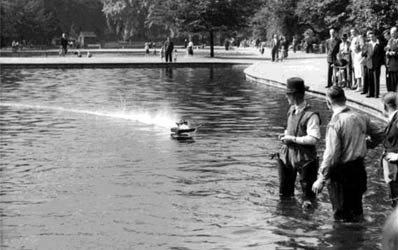 |
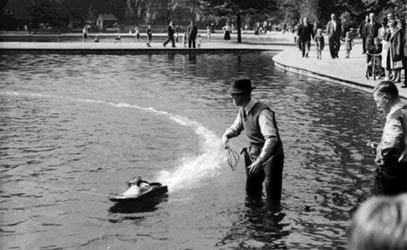 |
At Wicksteed Park in 1951, ‘Betty’ achieved her highest speed ever, showing that there was still life and development potential in this venerable boat. Over 500 yards in the Timpson Trophy race ‘Betty’ recorded 57.14mph to win the event, going on to win the 1000 yard Newman Loake as well. Remarkably, this speed was beaten at Victoria Park a short while later when finishing second to Stan Clifford but at a new high of 58.7mph.
|
|
The double success was not to be repeated in 1952 with John Benson wining both with his 30cc ‘Orthon’. As Meridian, he commented, ‘Both the pre-war veterans ‘Betty’ and ‘Faro’ seem to be off form this season, after some amazing performances put up in 1951.’ Appearances for Betty were now few and far between, although she was still capable of picking up the pieces when the much faster boats faltered. The last mention of ‘Betty’ in a race was in 1954 at the Forest gate Club event held at Victoria Park where she finished second in the Class A event at 50.32mph, although in somewhat spectacular style. ‘The speed events also provided some thrills, particularly when in the Class A race Mr J Innocent’s ‘Betty’ flipped at over 60mph. Although a double loop was achieved in this spectacular capsize, only minor damage was sustained, and a second run was completed successfully, this time at lower speed. It should be mentioned that ‘Betty’ is 21 years old this year, and the hull is now decorated with a little silver key!’ |
John Innocent’s name did continue to appear in the results for a while, as he was also straight running and steering with a boat called ‘Betsy’. At the same Victoria regatta as ‘Betty’ had somersaulted, John also came third in the steering event with 11 points. John’s final competitive season would appear to be 1955 when he ran ‘Betsy’ at the St Albans International meeting and again at the Kingsmere Regatta held at Victoria Park, where he won the Steering Competition.
|
The Innocent's Legacy Soon after retiring from racing, Betty was passed to Arthur Cockman who registered it under his number and used it for demonstrations on appropriate occasions. The late Tom Clement recalled visiting Arthur for a straight running event when they decided to try and start ‘Betty’ and give her a run. It was clear that the knowledge of the fine adjustments needed to make the engine run satisfactorily had not been passed on as there was a dispute between those present as to whether the engine should be adjusted with the prop in the water or out as was becoming the practice. Right: Gerry Buck at St Albans with Betty, Arthur Cockman below. |
|
Arthur Cockman in turn passed on most of the boats he had obtained to Gerry Colbeck Secretary of the MPBA, who also had a go at running ‘Betty’, aided and abetted by Stuart Robinson.
|
|
Unfortunately following the various attempts to get the boat running, the engine was not cleaned or inhibited, causing the piston to corrode and seize in the cylinder barrel, requiring the application of brute force to remove it. The engine was never reassembled properly and the cylinder head still rests on top of the cylinder with the holding down studs missing. It is not known if a replacement piston was ever fitted. Left: Spares retrieved from Olive Cockman. Standard aluminium piston on left with very high compression magnesium alloy version on right, along with spare prop. |
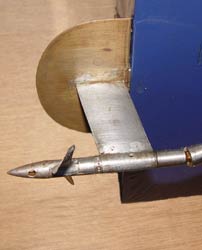 |
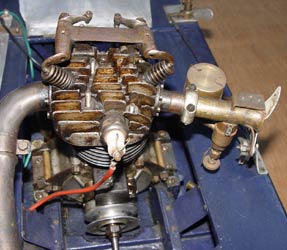 |
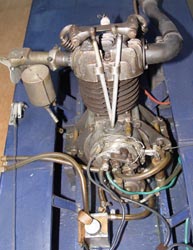 |
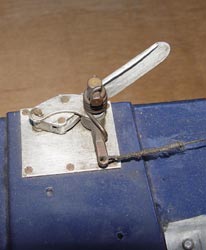 |
| Skeg and cavitation plate | Experimental 'electronic ignition' above and redundant coil ignition set up | Remnants of settings system | |
|
Like Ken Williams, with ‘Faro’, The Innocent Brothers went through their entire racing career with just the one boat, so apart from a few spares and bits and pieces that have survived, ‘Betty’ and her spare motor are the only tangible reminders of their long and successful involvement in tethered hydroplane racing. Of the straight runner ‘Betsy’, nothing further is known. In 1977 the Innocents donated the Windermere Trophy back to the MPBA for competition by waterscrew hydroplanes. This is awarded annually to the competitor breaking a current record by the largest margin or being closest to an existing record. |
|
|
|
The company that Sam founded, Coborn Engineering, continued to thrive and he was still working a six-day week at 76 years old. Pictured here in the early 1970's, Sam (right) with Peter Stanwell and the rotorfugal engine Peter developed, with guidance from Sam. His son John said that his father was dedicated to engineering and to the company. In August 1980 Sam passed away, with brother John dying just six weeks later. Doris, John's widow, is this year celebrating her 103rd birthday. Coborn Engineering continues under the stewardship of John, whose two sons are now also working in the firm. The Company won the Queens Award in 2012. |
When you start with just a boat and try and trace its history, you never quite know whether you will be able to find enough of the pieces to put together a story. Through the family contacts I have made, the Innocent Brothers emerged as totally different characters, who combined their engineering skills to create a very successful and competitive hydroplane. Happily, the first British racing hydroplane to win on French soil has survived, which along with Ken William’s ‘Faro’ and George Noble’s ‘Bulrush VIII’, represents the best from an era of this sport, now long gone.
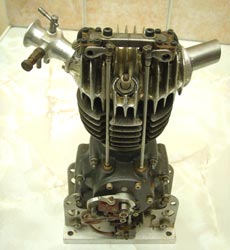 |
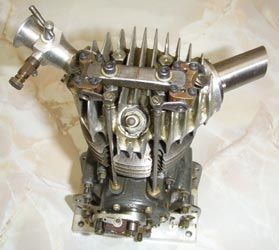 |
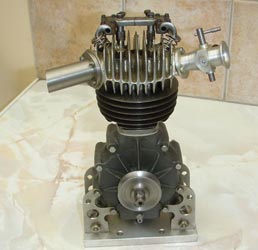 |
| Spare motor with crankcase cast from Elektron magnesium alloy | ||
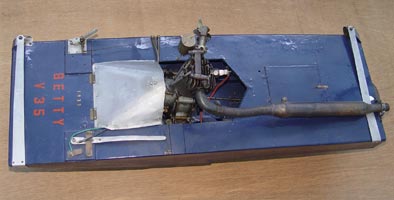 |
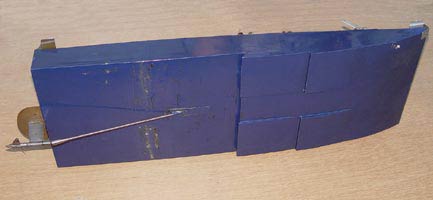 |
Many thanks to John Innocent,
Peter Hill, Stuart Robinson and the late Tom Clement for help in preparing this
article. Images courtesy of the
Westbury Collection,
John Innocent,
Keith Reynolds,
Jim Free and
Jim Jamieson.
There are two short clips of Betty running at Victoria Park in 1936 on the
British Pathe News. Go to
britishpathe.com and then type in Victoria Park
©copyrightOTW2013